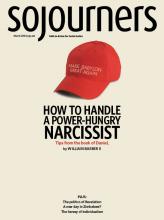AS THE CHURCH wends its way through Lent, the last days of Jesus become the focus of the lectionary. The story of those days is hopelessly entangled with the story of the early church establishing and defining itself. One consequence of this is the habit of the Johannine gospel (John 2:13-22) to blame “the Jews” for all that befalls Jesus. Its authors are a long way from Mark’s portrait of a Torah-observant Jewish Jesus (Mark 14:3-9). And yet John 3:16 proclaims the love of God for the world; no sibling rivalry can stand in the face of that love. Similarly, Jesus announces that he will draw all people to himself in John 12:32.
The epistles emphasize that Christ calls all, non-Jews (lumped together under the moniker “the Greeks”) and Jews, in 1 Corinthians 1:18. The emphasis on God’s love and mercy in Ephesians 2:4 makes this reading especially suitable for Lent.
The readings from Hebrews and Philippians on the last two Sundays focus on a heavenly Christ who is exalted, in sharp distinction to the earthly Jesus betrayed and executed in the passion gospel.
This diversity of texts reveals Jesus through the different lenses of his faithful at varying points in the church’s story, inviting us to add our vision and voice to the telling of that story.
[ March 4 ]
Exodus 20:1-17, Psalm 19; 1 Corinthians 1:18-25; John 2:13-22
THE TEN COMMANDMENTS spell out human responsibilities in the covenant between God and Israel, and subsequently to us, who have become party to that covenant. Not surprising, the commandments that pertain directly to God precede those that pertain to sister and brother human beings. The commandments are presented as being on the very lips of God. It is not clear whether God speaks through Moses or directly addresses the people. (In Exodus 20:18, the people witness the lightning, thunder, and smoke that accompany God’s speech and ask God not to speak to them, raising the possibility that they saw but had not heard or didn’t want to hear further.)
Read the Full Article

